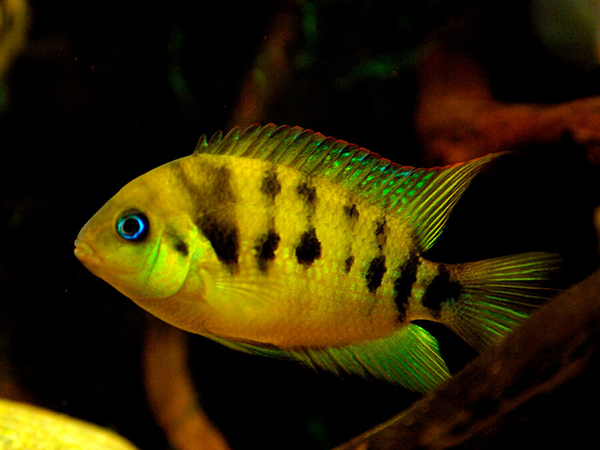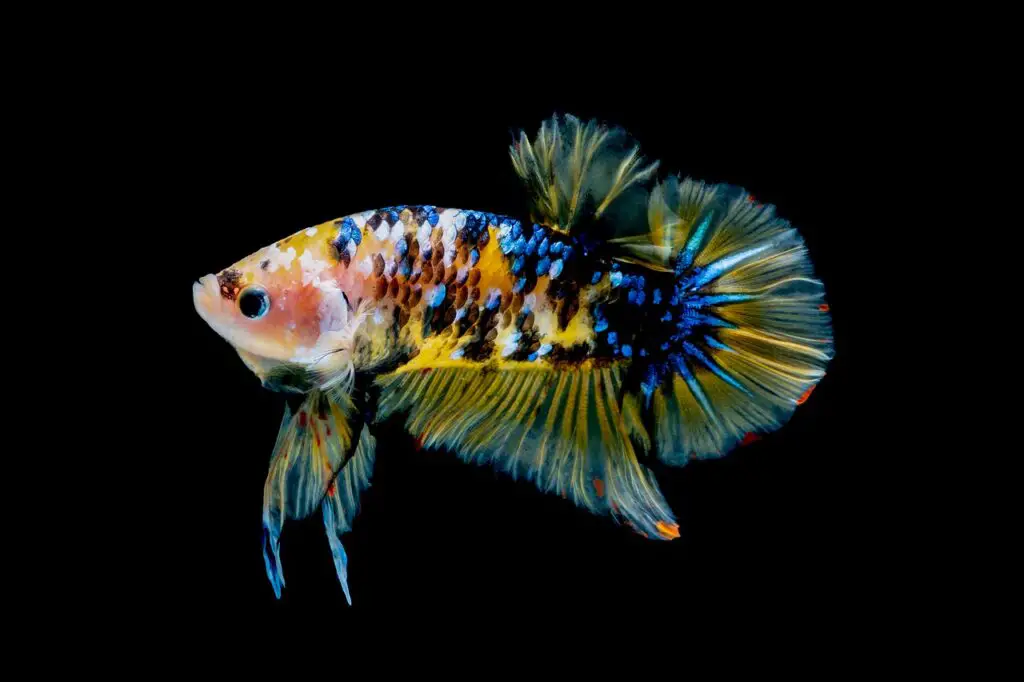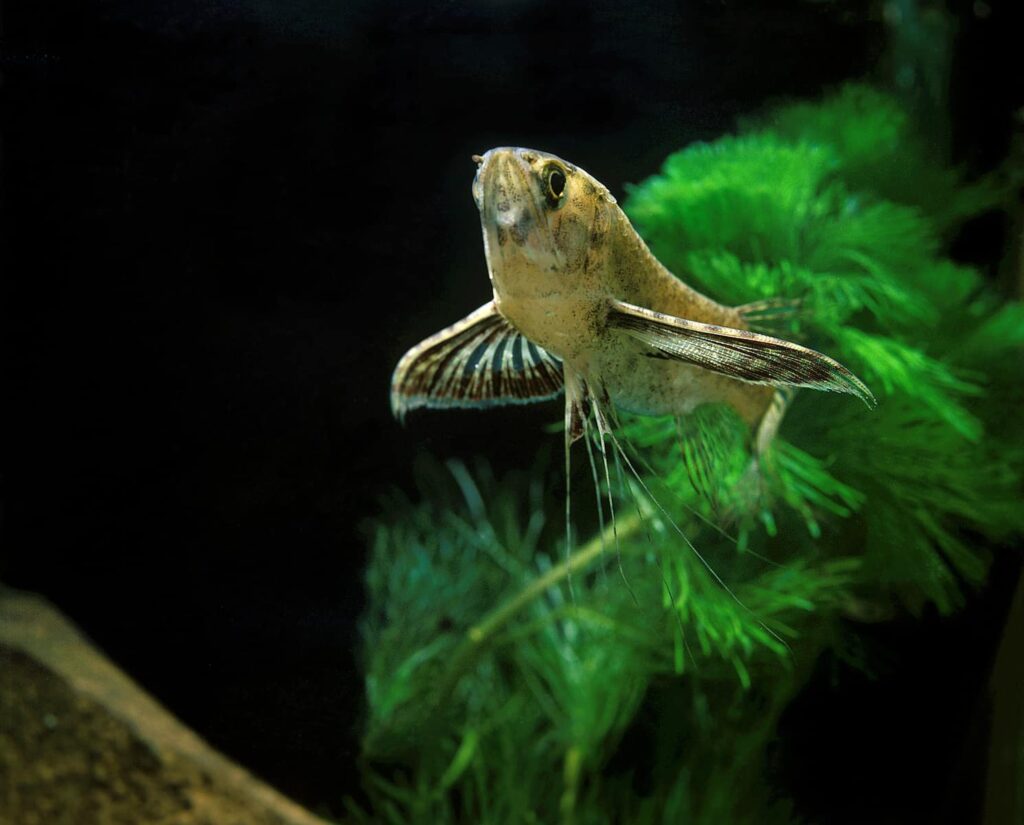The Amatitlania Nonolutea, also known as the Gold Convict, is a species of cichlid that’s relatively new to the fishkeeping scene. A rounded yellow body with black markings makes this fish stand out among other cichlids and is a great addition to any fish tank. Here’s an overview of their requirements:
| Size | 3-4 inches |
| Difficulty Level | Moderate |
| Temperament | Aggressive |
| Lifespan | 8-10 years |
| Recommended Minimum Tank Size | 30 gallons |
| Tank Mates | Catfish, Plecos, Danios, and Other Cichlids |
As you can see, the Gold Convict has some demanding requirements and isn’t necessarily a good fish for beginners. The rest of this article will walk you through the common Amatitlania Nanolutea profile to determine if it’s the right fish for your tank.
Origin
Hailing from Boca del Toro in Panama, the Gold Convict cichlid was first described in 1994, and its name is a pairing of the words ‘abundance’ and ‘small.’
Description
Gold Convict males can reach up to almost 4 inches (10 centimeters) in length, and the females tend to be a little smaller. What the convict lacks in size, it makes up for in beauty. A golden yellow color is accentuated by a green sheen on the head and blue on the abdomen. A red border lines the dorsal fin, while stretched black stripes run along the sides of the body.
Water
The Gold Convict cichlid prefers slightly warmer waters similar to its home in Boca del Toro. A water temperature range of 75 to 82 degrees Fahrenheit is ideal (24-28 degrees Celsius). The pH of the water should be neutral, ranging from 6.5-8. The General Hardness of the water should be between 5 and 8 for best results.
The light level in the water should be moderate, and an overhead fluorescent light provides adequate lighting for this species of fish. When you’re setting up the tank, use either a canister filter or an under gravel filter to emulate the conditions they’re used to in the wild.
Diet
As omnivores, the Gold Convict cichlid will eat just about anything you put in the tank. They should be fed a diet of both live and frozen food to meet their nutritional needs.
Flakes designed specifically for cichlids are perfect, but you should also incorporate live food to stimulate their hunting instincts. It gives your convict a better quality of life and engages them. Blanched veggies are also a valuable part of your cichlid’s diet.
Feed your Gold Convict three times a day with small meals and reduce feeding if there’s still leftovers after an hour. Feeding smaller meals more regularly helps prevent overeating and reduces aggression among cichlids. Here are some ideal foods for your Gold Convict:
- Flakes and pellets formulated for cichlids
- Bloodworms
- Brine shrimp
- Daphnia
- Lettuce
- Broccoli
- Carrots
- Cucumbers
- Spinach
A variety of foods is best to keep your convict happy and healthy.
Character
Gold Convicts are territorial and aggressive. They don’t get along with other fish and don’t make for very good community tankmates. They will nip you given the opportunity, so be sure to watch your fingers when you’re operating in the tank. When put into a tank, they will scout it out and select a home.
When they’ve found a suitable log or rock to call their own, they’ll clear out any debris from the area. Usually, they’ll spend most of their time sticking to the bottom of the tank near their territories and are best kept in a species-only tank to mitigate aggression towards other smaller fish.
They’re quite adept at digging up plants, so make sure you’ve got hardy plants that can handle a little roughhousing and have strong root systems. Sword plants are ideal for beginners, provide adequate cover for hiding places, and can handle some roughing around by cichlids.
Tank Mates
The Gold Convict is quite aggressive, which means that its tankmates need to either be able to stand up for themselves or be passive enough to stay out of the way.
As such, other aggressive or semi-aggressive fish like Oscars, Firemouths, and Jewel Cichlids work with the Gold Convict, as long as you’ve got a big enough tank for each cichlid to have its own territory, reducing the risk of disputes and spreading the aggression among a large group.
On the other hand, passive tankmates are also workable. The Pictus Catfish, for example, is a good pairing since it is non-aggressive and sticks to hiding at the bottom of the tank. They are nocturnal and won’t cross paths with your cichlid often, greatly reducing the risk of aggressive behavior from your Gold Convict.
The common pleco is another great option if you have a large tank, preferably over 100 gallons. Common plecos are more active at night and prefer to hide away in caves. As long as you’ve got plenty of hiding spaces, there’s no risk of conflict between a Gold Convict and common pleco.
If you don’t have a massive tank, the Bristlenose Pleco is another good pick that’s compatible with the Gold Convict as long as you provide adequate space and hiding spots.
Lastly, Tiger Barbs are another good pairing with convict cichlids, both due to their nature and color matching. Tiger Barbs are semi-aggressive, but tend to be more docile around larger cichlids.
This protective nature makes them a more difficult target for the Gold Convict, especially in large schools. Similarly, schooling helps prevent the barbs from nipping at the convict as well. Make sure to opt for adult barbs since juveniles are too small to defend themselves from a large convict.
Final Thoughts
Gold Convict cichlids are a great option for people looking to do a species-only tank or fish keepers who love cichlids. The Gold Convict has a beautiful coloring and is suitable for a range of tank conditions. The difficulty in keeping Gold Convicts, as with most cichlids, is their temperament.
For best results, Gold Cichlids should be kept in a species only tank with plenty of rocky holes and crevices to hide in.



